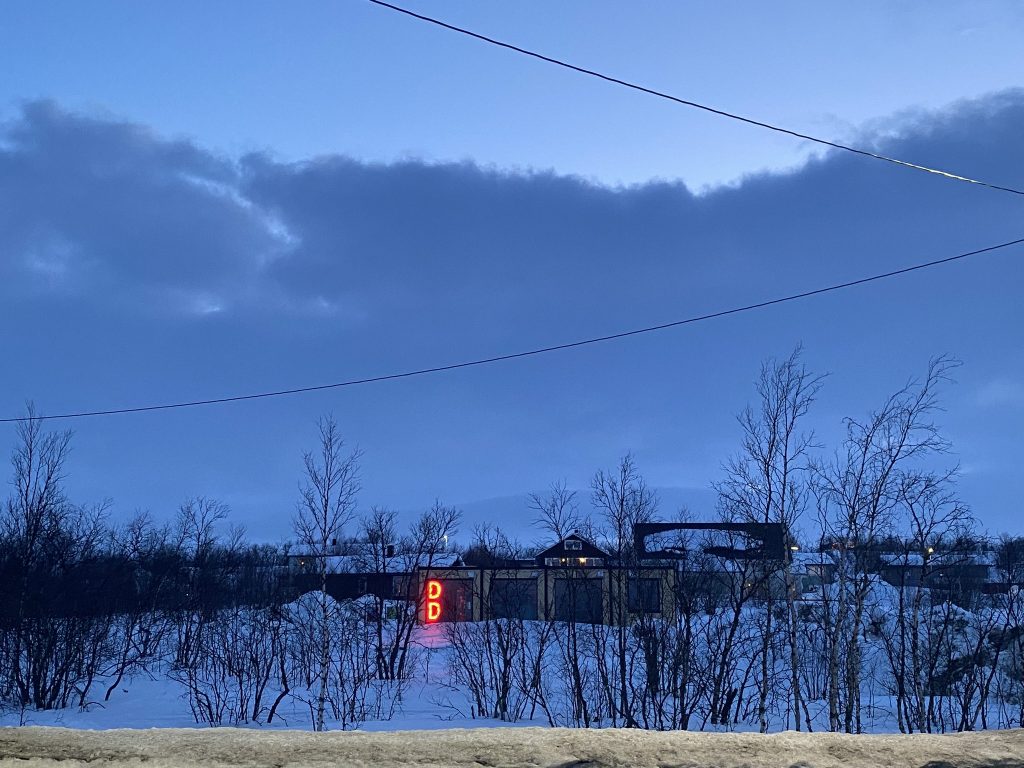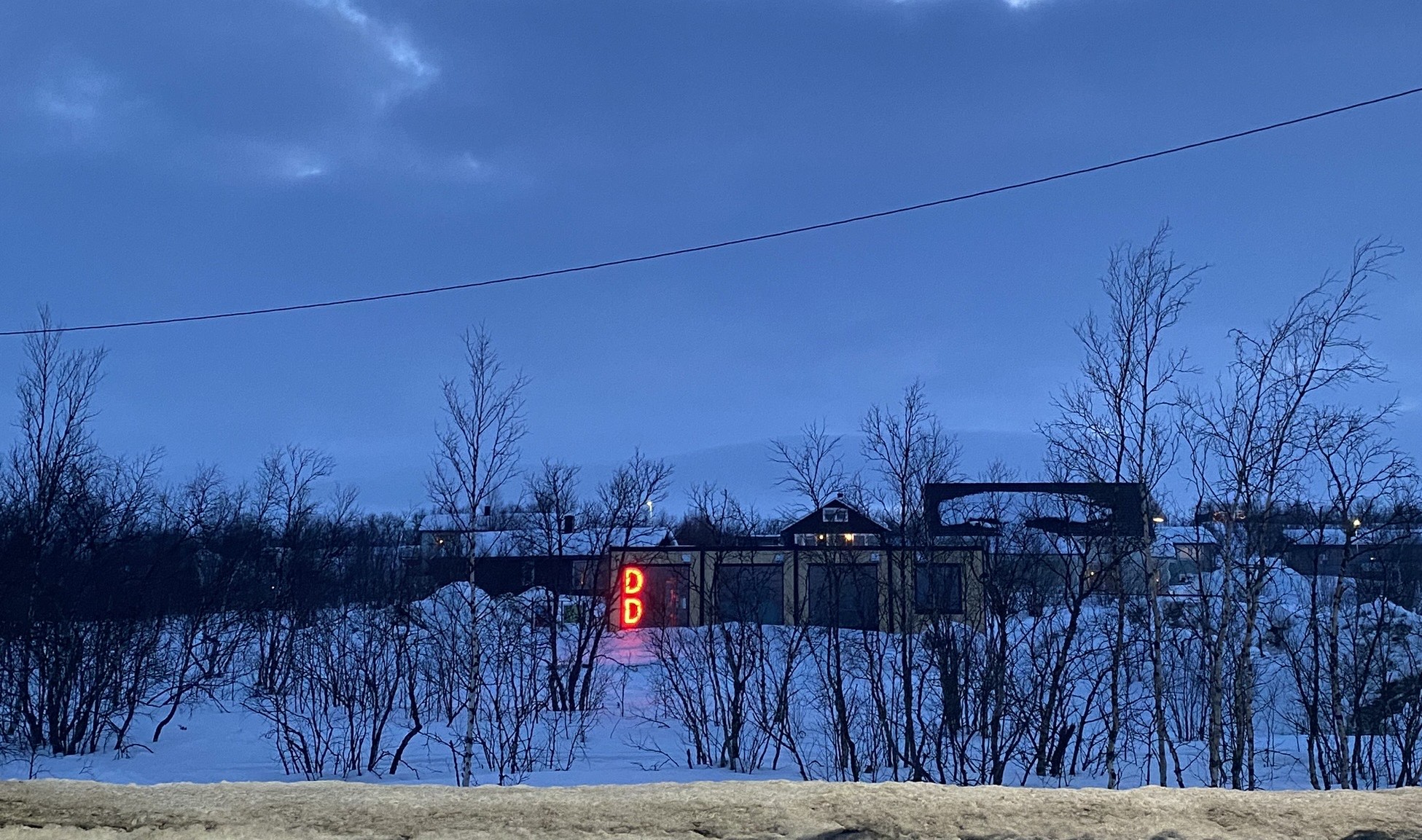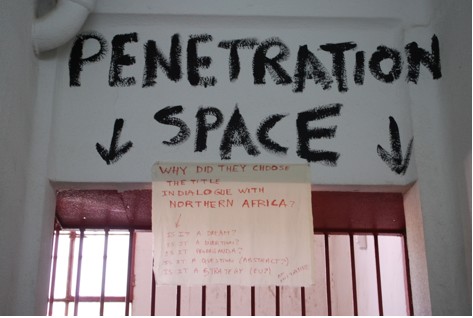Almost 300 kilometres beyond the Arctic Circle, on the Finnmark Plateau, Norway, lies a village of 1500 people where, for two months of the year, the sun never rises and for many more months the river and lakes remain frozen. In April, when I visited for the Sámi Easter Festival, the landscape resembled a vast white canvas dotted with occasional markings – rooftops, service wires, bare Birch trees – and fringed by hills that merge with a pale blue sky. But this restrained panorama is deceptive. Beneath the expanse of snow a remarkable creative community is at work.
 Guoµvdageaidnu/Kautokeino, home of the Dáiddadallu Sámi arts network. Photo courtesy of the author.
Guoµvdageaidnu/Kautokeino, home of the Dáiddadallu Sámi arts network. Photo courtesy of the author.
Guoµvdageaidnu/Kautokeino, one of two Sámi cultural centres in Northern Norway, is home to film, theatre, and creative learning institutions, including an indie Sámi music venue, craft workshops, and a museum, among other cultural centres. Since 2014 it has also been home to Dáiddadállu, a Sámi arts network. Originally a collective, it now has twenty-one members representing a broad range of disciplines including visual artists, photographers, sculptors, actors, and choreographers, among others. While some members live or work in other regions, all have a close connection to the area.
Sámi artist and writer, Máret Ánne Sara, is one of the two founding members of Dáiddadállu. In 2022 she participated in the Venice Biennale where, in a historic first, the Nordic Pavilion was transformed into the Sámi Pavilion. The exhibition’s aim was to celebrate ‘the art and sovereignty of the Indigenous Sámi people’. Three artists were chosen to represent Sápmi, the Sámi homeland which spans several countries: Norway, Sweden, Finland, and the Kola Peninsula in Russia. For Sara, the Biennale provided an opportunity to ‘seek and manifest faith and hope’ through a series of pieces intended to heal and repair trauma inflicted on her family as a result of a seven-year legal battle with the Norwegian state to defend the reindeer herding rights of her younger brother. The Sámi Pavilion reflected the growing national and international recognition of Sámi art, an acknowledgement that has taken decades of hard work to achieve.
Home for Sara is Guovdageaidnu. In 2014, finding it difficult to work alone as an artist, she contacted Elle Sofe Sara, a choreographer and filmmaker, who was also looking to connect with other artists with the same background. Together they formed Dáiddadállu with the aim of getting together with other Sámi artists and developing an environment in which art could be created in the most favourable conditions. Goals included making their art visible locally, nationally, and internationally, networking both within and beyond the Sámi community, and developing discussions about society through art.
The idea of a Sámi collective of artists was not a new one. Between 1978 and 1983 the pioneering group Mázejoavku strove to establish Sámi art within the contemporary art scene while also taking a political stance in terms of Sámi rights and identity. Funding challenges and a sense of defeat after the Alta Actions (concerning the construction of a hydroelectric power plant in the Alta River), ultimately put an end to the Máze collective. Its work, however, was an inspiration for Dáiddadállu, according to member, photographer, graphic artist, and writer, Susanne Hætta, who wrote a book about the history of Mázejoavku. Dáiddadállu is now in its tenth year and in March 2023 opened a purpose-built studio and centre for exhibitions, professional development, and networking.
A snow-covered road, lined on both sides by snow piles, led me to the Dáiddadállu studio. Outside, the temperature hovered around -8°C and two wide shovels leaning by the front door looked well used. The opening day of the Easter Festival was underway. In the courtyard, a ‘nomadic’ photographic exhibition created by Dáiddadállu, which had just arrived back after travelling around Northern Norway, featured prints from Máret Ánne Sara’s powerful Oaivemozit/Galskap/Madness (2013) and a still from Elle Sofe Sara’s film, The wind whispers there is someone behind the tundra (2007), which, in its depiction of dancers travelling through snowy landscape to meet their ancestors, seemed to merge with the environment.
Inside, I was offered coffee and a seat on a comfortable sofa. On the white walls, photographs, paintings, and textile works hung between the floor and the ceiling windows, through which the snowy landscape of the valley was visible. Black-and-white lino prints by Susanne Hætta, from an ongoing project Ruoktu (Home), were attached to bright red, blue, and wine-coloured Sámi scarves woven by Hætta’s aunt from her grandmother’s patterns. Visual artist, writer, and scenographer, Hilde Skancke Pedersen explored the nature of light during the polar nights, a time when vibrant colours, created by the sun shining upwards from beneath the horizon, brighten the dark skies. Her series Jaguáiggit (Seasons) (2021–ongoing) consists of photographs printed on canvas, overlaid with textile, acrylic paint, and other media. Upright glass cases exhibited new work in gold and silver by jewellery designer Ann-Sofie Kallok, and sculptures in bone and wood by Máret Ánne Sara. In a darkened room to one side continuous screenings of films, including Elle Márjá Eira’s Ealle-Girdnu/Reindeer Corral (2021), a 360-degree film that featured as part of the extended programme of the Sámi Pavilion.
Politics, art, and identity are closely intertwined in Sámi culture. In April memories of the protests in Oslo against the Fosen wind farms were still fresh and the rhythmic chant of CŠV (Show Sámi Spirit) accompanied more than one performance. A photo being exhibited by Máret Ánne Sara asked which of the following is mad: The Sámi communities foreseeing a world on the brink of destruction? Or the people denying the consequences foreseen by the people affected? ‘Our most important purpose for doing art is because we need to protect our lands … this is our calling, and if we don’t do it, we will lose everything,’ Susanne Hætta told me. ‘That’s why I write and make art about Sámi people, Sámi lives, and Sámi reality, and Sámi history.’
Dáiddadállu member Anthoni Hætta is a trained musician and pianist. He spent many years living and studying in the south of Norway and Finland but returned to live in Guovdageaidnu. The cost of travel and lack of professional musicians in the area make working in music, in such a geographically isolated village, challenging. But Anthoni Hætta has no reservations about returning to live in his homeplace; ‘It’s so important to be in a place where I can speak the Sámi language, work in Sámi and where I could be, you know, a resource for the community.’ With his business partner he co-founded Davvi Division, a cultural centre and an indie stage that offers a performance platform to Sámi musicians. ‘Our aim is to give accessible culture and events,’ Anthoni Hætta told me. ‘Everything is free because we want art and culture to be accessible to everyone, no matter what kind of economical background you have.’
Anthoni Hætta believes the basis of his musical understanding comes from yoiking (traditional Sámi singing) that, like so many other Sámi people, formed an important part of his upbringing. His work today includes performing, arranging, and teaching music and he recently published the first music book for children in Sámi. He is currently working in composition with a yoik, ‘breaking it down into pieces and manipulating the sounds and then putting it back together, making it that you can’t … hear it’s a yoik anymore’. He is interested in exploring what defines Sámi music.
During the Sámi Easter Festival, the breadth of creative expression was evident in the handmade costumes and intricate gold and silver jewellery worn by Sámi people. Tables in the craft market were laden with felted socks and bags, boots, and coats made from reindeer skin. Evocative melodies flowed out of the festival Lavvu tent where people of all ages were yoiking. Elsewhere, location filming for Stolen, the first Sámi film for Netflix, which is being directed by Dáiddadállu member Elle Márjá Eira, was underway.
Reflecting on the conditions that have resulted in this fertile creative ground, Susanne Hætta told me that ‘almost all Sámi have a creative expression’, adding that ‘most of us are multi-disciplinary … that’s truly a Sámi thing … we need to know and to do many things to be able to get by traditionally in Sámi society’. Anthoni Hætta suggests the social aspect of their culture has a lot to do with this: ‘Guovdageaidnu is the one place that the Norwegians couldn’t Norwegianise completely. So, I think it’s a cultural stubbornness … a deeply rooted Sámi identity that’s not going anywhere … Being so rooted and having such strong languages is going to attract people who want to be in the midst of it… That’s what makes it very interesting because it is pulsating even though it is a small place … and all these artists are doing it from a Sámi perspective.’
As Dáiddadállu approaches its tenth anniversary there is a sense that many years of work is beginning to pay off. ‘Everything is happening now, but we really worked hard for it,’ Susanne Hætta told me. ‘Sometimes that’s not enough, to do work of high quality … you can shout out and nobody listens to you but now there is a new type of attention to other cultures and other stories.’ The international attention has been of benefit to Sámi art within Norway too, as it has helped to attract the attention of Norwegian authorities. But for the members of Dáiddadállu, the connections that have been forged over many decades and strengthened over the past ten years are bearing fruit. ‘We don’t compromise with artistic quality or with our culture.’ Hætta is firm. ‘We want to present our films and our stories ourselves. Not let others do that because they have done that for hundreds of years. Now is our turn to do that ourselves.’
Sheila de Courcy is a writer based between Dublin and West Waterford.




